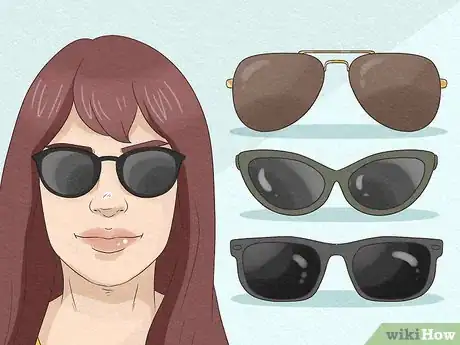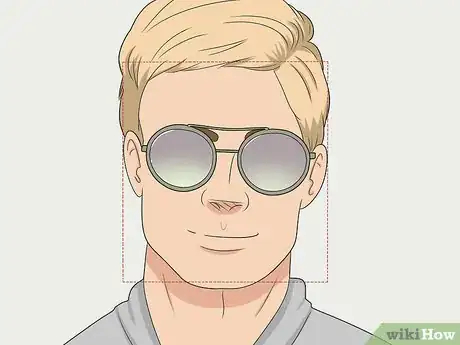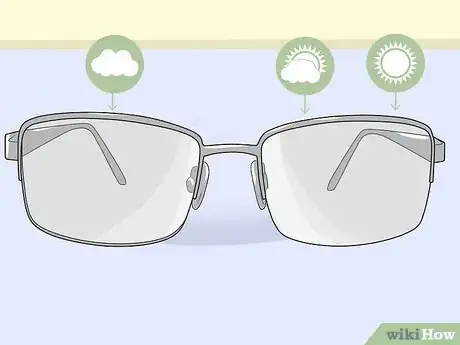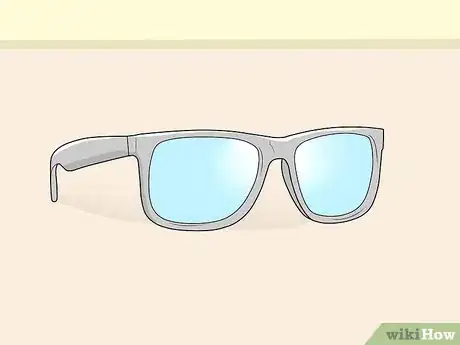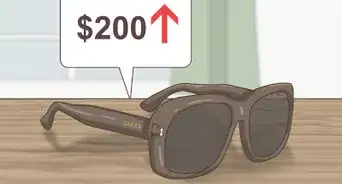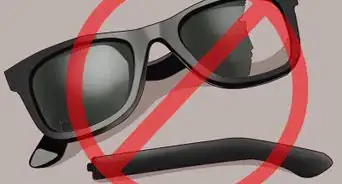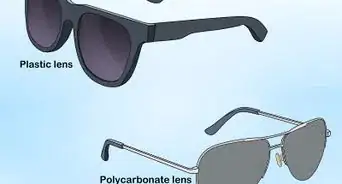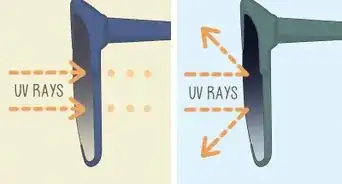This article was co-authored by Luxme Hariharan, MD, MPH. Dr. Luxme Hariharan is a Board Certified Pediatric Ophthalmologist. She currently is a Pediatric Ophthalmologist at Nicklaus Children's Hospital in Miami, Florida. She specializes in pediatric ophthalmology and preventing childhood blindness. Dr. Hariharan has worked with global institutions including the World Health Organization, the American Academy of Ophthalmology, Orbis, and Sightlife. She holds a BS in Biology and Latin American, Caribbean & Iberian Studies from The University of Wisconsin-Madison, a Masters of Public Health (MPH) in International Health, Child Health, Epidemiology & Biostatistics from Johns Hopkins University, and an MD from The University of Wisconsin-Madison. She is a member and serves on several committees within the American Academy of Ophthalmology, The American Academy of Pediatric Ophthalmology and Strabismus; and sits on the board of directors of Combat Blindness International.
wikiHow marks an article as reader-approved once it receives enough positive feedback. In this case, several readers have written to tell us that this article was helpful to them, earning it our reader-approved status.
This article has been viewed 537,628 times.
There are so many options to choose from when it comes time to pick a new pair of sunglasses, which can make the process fun but also a little daunting. Start by picking out the right size and style of frames for your face shape. From there, you can decide what color of lens is going to fit your needs best. Take your time making your decision and enjoy your new and improved pair of sunglasses!
Steps
Picking Sunglasses Based on Your Face Shape
-
1Opt for large brown or black frames if you have an oval-shaped face. If you have an oval-shaped face, you can wear almost any pair of frames you like. Darker colored lenses will accentuate your cheekbones. Cat-eye frames, aviators, round frames, squared frames, and others are fun options for you to explore.[1]
- If your face is oval-shaped but also on the smaller side, stick with smaller, shorter frames instead of overly-large ones so that your facial features aren’t hidden. Wayfarer, hingeless, rectangle, and rimless or semi-rimless frames would be good options to look into.
- With an oval-shaped face, you may want to pay more attention to your hair color and skin tone. For example, if you have pale skin, brown sunglasses could play nicely against your light skin. If you have darker skin, black frames could look very sophisticated. Green could look nice against pale skin, and yellow looks great against darker skin. Try out a few options to see which looks best.
Determine Your Face Shape: Look directly into a mirror and use a dry-erase marker or some lipstick to trace the outline of your face onto the mirror. Step back and look at the shape. Is it most like a square, a circle, an oval, or a heart?
-
2Pick smaller frames or cat-eye glasses if you have a heart-shaped face. Heart-shaped faces tend to have larger brows and a smaller chin. Too-large sunglasses will take over your face and look bulky. In addition to cat-eye frames, round glasses, smaller rectangular glasses, and rimless glasses are nice options to pick from.[2]
- Pick a color of shade that complements your skin tone. For example, if your skin has red undertones, steer clear of red or pink shades—opt for a cooler color, like blue or purple.
Advertisement -
3Go for a bigger, rounder frame if you have a square-shaped face. If you have wide cheekbones, a wide forehead, and a noticeable jawline, you most likely have a square-shaped face. If you wear small frames, they could make your face look bigger than it is. Avoid sunglasses with lots of angles, as they will make your face look boxy.[3]
- Aviators in the classic, teardrop, or square shape are great picks if you have a square-shaped face.
- Black frames tend to look larger than colored frames. If you don’t want black sunglasses, opt for a deeper color, like gray, purple, or even dark green.
-
4Choose a wider, angled frame if you have a round-shaped face. Round faces tend to be about equal in height and width, so it’s important to choose sunglasses that are a little wider than the broadest section of your face. Rectangular and square sunglasses are great options for this face shape, as are wayfarer, sport, and retro frames.[4]
- Avoid circular frames, as they will just make your face look rounder.
- Don’t be afraid to pick lenses with a little bit of bling around the edges. A cool pattern, rhinestones, or even glitter can be a great addition to your sunglasses.
Choosing the Right Color Lens
-
1Opt for brown or amber lenses if you need to see far distances easily. If you play golf, spend time hiking in the great outdoors, go boating, or do anything else that requires you to look out at long distances, amber lenses can improve your depth perception and strain your eyes less than other lenses would. The red hue makes the contrast between landscape and sky much more apparent.[5]
Warning: Amber and brown frames aren’t the best for cloudy conditions so they don’t make the best driving sunglasses. They can impair your vision a little bit if the light is dim.
-
2Pick gray or black lenses if you live in an equally sunny and cloudy area. Darker lenses reduce glare, provide protection for your eyes, and keep your eyes from getting fatigued. They’re a good pick if you do a lot of outdoor activities, like jogging, biking, or fishing, and they are also a good pick to wear while driving.[6]
- Gray lenses are also great for people who love spending time in nature—you should still be able to see the things around you in their most natural color.
-
3Look stylish while protecting your eyes with blue sunglass lenses. Blue lenses reduce glare, help you see details more clearly, and are good for both sunny and cloudy conditions. Plus, they look fashionable![7]
- Blue lenses are popular with people who enjoy snow sports, like snowboarding and skiing. Because they reduce glare from the sun, they help you see further in icy and snowy conditions.
-
4Choose green lenses for an all-around great pick to protect your eyes. Green lenses can kind of do it all—they make colors brighter and shadows darker so it’s easier to see what’s happening around you, they’re great for both cloudy and sunny conditions, and they reduce glare.[8]
- If you don’t want others to be able to see your eyes, green probably isn’t the best pick for you.
-
5Get yellow lenses if you often need to be able to see well in low-light. Hunters, outdoor basketball players, tennis players, cyclists, and other people who tend to run into fog or low-visibility during their activities can benefit from yellow lenses. They can help you focus your sight on what’s in front of you, even when the light is dim.[9]
- Yellow lenses are also a good option for people who spend a lot of time on the computer or playing video games. It may seem strange to wear sunglasses indoors, but they can do a lot for the health of your eyes.
- Yellow lenses aren’t the best for driving. Even though they help you see in better in low-light, they aren’t great at blocking out glare.
-
6Increase your field of vision and block blue light with red lenses. Red lenses are great for really bright conditions, like skiing or using a computer for more than several hours a day. They’re also great if you spend a lot of time on the road as they help you see better for further distances. Blue light is also an issue for people who spend the majority of their day looking at screens, so even they can benefit from red lenses.[10]
- In addition to helping you see better in various conditions, red lenses can also comfort your eyes and help them experience less strain. They’re very versatile and are suitable for all conditions!
Adding Special Features
-
1Invest in a pair of prescription sunglasses if you are a glasses-wearer. If you need a prescription to see clearly, you don’t want to have trouble with your eyesight every time you wear your sunglasses. Many providers will insert prescription lenses into frames you already have, or, you can buy a new pair with the prescription already included.
- If you don’t want to have to switch your glasses out for sunglasses every time you need them, you could get a pair of prescription clip-on sunglasses.
- If you regularly wear contacts, there’s no need to get prescription sunglasses.
-
2Opt for an all-in-one pair of glasses with photochromic lenses. If you have prescription eyeglasses, photochromic lenses will transition from clear to dark based on the presence of UV rays, meaning that you don’t need to worry about forgetting your sunglasses at home or in the car the next time you’re outside. They can take longer to transition in the car or really cold weather, so be ready for a slight delay in those situations.[11]
- Photochromic lenses provide UV protection at all times.
- You can get photochromic lenses put into almost any frame that you’d like, and they are compatible with bifocals, progressive lenses, and shatter-resistant lenses, too.
-
3Get polarized lenses if you play water sports or hate the glare from the sun. If you want to be able to see more clearly without having to squint your eyes, polarized lenses are a great option. They block the reflection of the sun and reduce glare so that you can see more clearly.[12]
- Most polarized lenses also include UV protection.
Warning: Avoid polarized lenses if you snowboard, ski, or ride motorcycles. For these activities, being able to see the sun reflecting off of ice or wet pavement can help keep you safe!
-
4Pick close-fitting or banded sunglasses if you play a lot of sports. The last thing you want while you’re in the middle of a basketball game, run, or skiing session is to suddenly lose your sunglasses. If your sunglasses tend to be a little loose, take them to an optometrist to have them tightened up. Or, invest in a pair of sunglasses that has a band that wraps around your head for ultimate security.[13]
- The banded sunglasses can be especially helpful if you get sweaty while you’re outside. Sweat can cause frames to lose their grip and slip off your head.
References
- ↑ https://www.thetrendspotter.net/how-to-pick-the-best-sunglasses-for-your-face-shape/
- ↑ https://www.thetrendspotter.net/how-to-pick-the-best-sunglasses-for-your-face-shape/
- ↑ https://www.thetrendspotter.net/how-to-pick-the-best-sunglasses-for-your-face-shape/
- ↑ https://www.thetrendspotter.net/how-to-pick-the-best-sunglasses-for-your-face-shape/
- ↑ https://www.vsp.com/eyewear-wellness/lasik-glasses-lenses/glasses-lenses/lens-enhancements/sunglass-lenses
- ↑ https://www.vsp.com/eyewear-wellness/lasik-glasses-lenses/glasses-lenses/lens-enhancements/sunglass-lenses
- ↑ https://www.vsp.com/eyewear-wellness/lasik-glasses-lenses/glasses-lenses/lens-enhancements/sunglass-lenses
- ↑ https://www.vsp.com/eyewear-wellness/lasik-glasses-lenses/glasses-lenses/lens-enhancements/sunglass-lenses
- ↑ https://www.vsp.com/eyewear-wellness/lasik-glasses-lenses/glasses-lenses/lens-enhancements/sunglass-lenses
About This Article
To pick sunglasses, identify your face shape and pick glasses that compliment it. If you have an oval-shaped face, consider an Aviator style and avoid frames that are wider than your face. For a round face, choose thicker frames with a square design to balance plump cheeks. Similarly, pick a larger lens and polygonal frame if you have a long face. Round, wider sunglasses are a good choice for people with a square face, because they minimize a pronounced jawline. For tips on how to choose a lens color for your sunglasses, read on!
